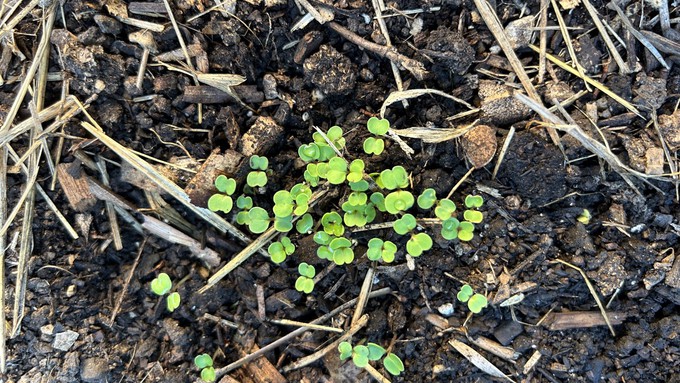
‘Atmospheric river’ could soak Sacramento with 1.5 inches of rain

Arugula sprouts quickly and can still be started in the cool-weather garden. Keep the soil moist. (The rain we get this next week should help.) Kathy Morrison
According to the National Weather Service, our first “atmospheric river” of the 2023-24 rainy season is on its way to Northern California. It’s expected to start drizzling Tuesday morning in Sacramento and won’t let up until Friday afternoon.
For the most part, this rain won’t be heavy but it will be consistently threatening. The weather service predicts “likely rain showers” starting at 4 a.m. Tuesday and forecasts “likely” or “chance rain showers” every single hour after that until 4 p.m. Friday.
How much rain will we get? Sacramento’s final total will be about 1.5 inches, predicts the weather service. That will boost our monthly rain total to close to normal. November average’s 2.08 inches of rain in Sacramento. So far, we’ve received 0.12 inches.
This storm bodes well for another wet winter. Our first atmospheric river of 2022 arrived Nov. 7, starting one of the wettest years in Sacramento history.
Before this new storm arrives, this may be our last sunny 70s weekend of 2023. All that incoming cloud cover will keep high temperatures in the low to mid 60s, which is normal; our average for mid-November is 64.
Make the most of this sunny break before rain. Get outside and garden!
* Turn off the sprinklers; Mother Nature should take care of irrigation this week.
* Rake and compost leaves, but dispose of any diseased plant material. For example, if peach and nectarine trees showed signs of leaf curl this year, clean up under trees and dispose of those leaves instead of composting.
* Make sure to rake leaves away from storm drains and keep gutters clear so water doesn’t pond in the street.
* Give your azaleas, gardenias and camellias a boost with chelated iron.
* Prune non-flowering trees and shrubs while dormant.
* Pull faded annuals and vegetables.
* Save dry stalks and seedpods from poppies and coneflowers for fall bouquets and holiday decorating.
* Prune dead or broken branches from trees.
* Keep planting bulbs to spread out your spring bloom. Some possible suggestions: daffodils, crocuses, hyacinths, tulips, anemones and scillas.
* This is also a good time to seed wildflowers and plant such spring bloomers as sweet pea, sweet alyssum and bachelor buttons.
* Now is the best time to plant most trees and shrubs. This gives them plenty of time for root development before spring growth. They also benefit from fall and winter rains.
* Set out cool-weather annuals such as pansies and snapdragons.
* Lettuce, cabbage and broccoli also can be planted now.
* Plant seeds for radishes, beets, bok choy, chard, arugula, mustard, spinach and peas.
* Plant garlic and onions.
Comments
0 comments have been posted.Sacramento Digs Gardening to your inbox.
Sites We Like
Garden Checklist for week of April 21
This week there’s plenty to keep gardeners busy. With no rain in the immediate forecast, remember to irrigate any new transplants.
* Weed, weed, weed! Get them before they flower and go to seed.
* April is the last chance to plant citrus trees such as dwarf orange, lemon and kumquat. These trees also look good in landscaping and provide fresh fruit in winter.
* Smell orange blossoms? Feed citrus trees with a low dose of balanced fertilizer (such as 10-10-10) during bloom to help set fruit. Keep an eye out for ants.
* Apply slow-release fertilizer to the lawn.
* Thoroughly clean debris from the bottom of outdoor ponds or fountains.
* Spring brings a flush of rapid growth, and that means your garden is really hungry. Feed shrubs and trees with a slow-release fertilizer. Or mulch with a 1-inch layer of compost.
* Azaleas and camellias looking a little yellow? If leaves are turning yellow between the veins, give them a boost with chelated iron.
* Trim dead flowers but not leaves from spring-flowering bulbs such as daffodils and tulips. Those leaves gather energy to create next year's flowers. Also, give the bulbs a fertilizer boost after bloom.
* Pinch chrysanthemums back to 12 inches for fall flowers. Cut old stems to the ground.
* Mulch around plants to conserve moisture and control weeds.
* From seed, plant beans, beets, cantaloupes, carrots, corn, cucumbers, melons, radishes and squash.
* Plant onion sets.
* In the flower garden, plant seeds for asters, cosmos, celosia, marigolds, salvia, sunflowers and zinnias.
* Transplant petunias, zinnias, geraniums and other summer bloomers.
* Plant perennials and dahlia tubers for summer bloom.
* Mid to late April is about the last chance to plant summer bulbs, such as gladiolus and tuberous begonias.
* Transplant lettuce seedlings. Choose varieties that mature quickly such as loose leaf.